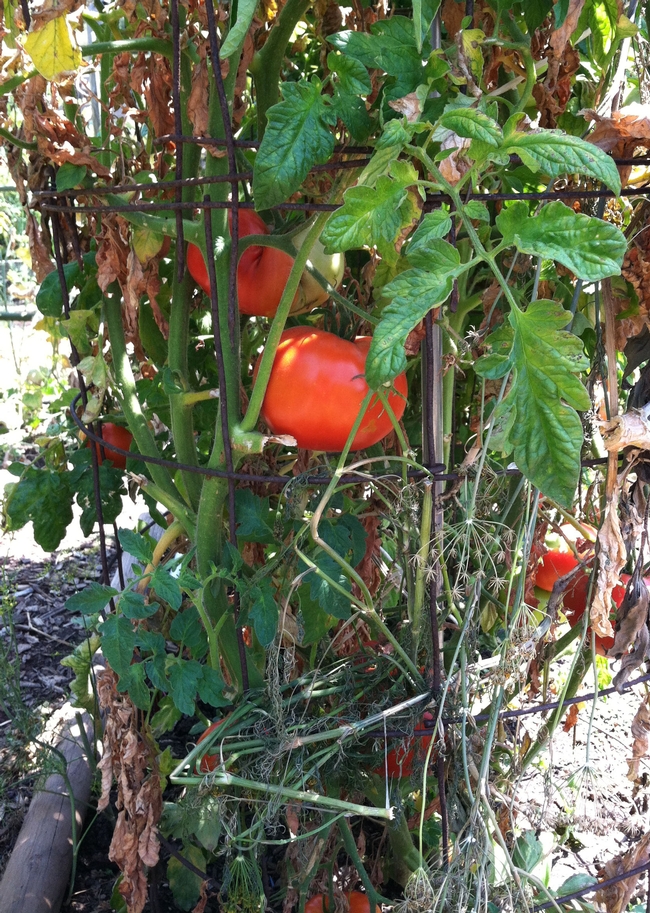Posts Tagged: Susan Algert
Gardens contribute vegetables, ease hunger among San Jose residents
People who grow their own vegetables in a garden typically consume enough fresh produce to meet the USDA Dietary Guidelines for a healthy diet, according to a recent UC Cooperative Extension survey of San Jose residents.
A diet containing lots of vegetables is lower in calories and higher in fiber and good for our health. Yet, not everyone has easy access to fresh vegetables in the United States.
“Growing vegetables and having a garden is an effective intervention to promote increased vegetable consumption among all Americans,” said Susan Algert, UC Cooperative Extension advisor in Santa Clara County, who conducted the survey. “This is evidence for bringing back popular home gardens or ‘Victory gardens' of the past rather than investing exclusively in SNAP benefits for purchased foods.”
SNAP, the federal Supplemental Nutrition Assistance Program (formerly called food stamps), now allows participants to buy seeds with their benefits, which helps low-income people who want to grow their own veggies, she said.
Vegetable consumption falls well below the U.S. Dietary Guidelines in much of the U.S., particularly among African American, Latino, low educational attainment, and low-income populations.
Algert and fellow UC Cooperative Extension researchers looked at background characteristics, vegetable intake and program benefits of people who cultivated a home garden versus those who participated in a community garden.
“The home gardeners were significantly younger, had lower incomes, were less likely to have completed college and were more ethnically diverse than the community gardeners,” said Algert, who specializes in nutrition. “In other words, the background characteristics of the two groups varied significantly. In spite of these significant demographic differences, both groups increased their vegetable consumption from the garden to the same extent, by about two servings.”
In fact, by supplementing with food from their gardens, both groups met the U.S. Dietary Guidelines for recommended daily servings of vegetables to promote optimal health.
A lack of experience as gardeners didn't affect the results much. Fifty eight percent of the home gardeners reported having less than two years of experience whereas only one-third of community gardeners were novices.
“This study demonstrates that growing fresh vegetables in either a home or community garden setting can contribute significantly to a person's nutritional intake and food security at all income levels by making it a more affordable to maintain a healthful diet,” said Algert. Urban gardeners also experience a number of other benefits including exercise, stress release, and learning about gardening from their peers and mentors.
The study was a partnership with the Parks, Recreation and Neighborhood Services Department of the City of San Jose and La Mesa Verde, a project of Sacred Heart Community Services of San Jose. The UCCE research group worked with the Parks Department to administer a 30 question background survey to 83 community gardeners in four different gardens during April through September 2012. The same survey, slightly modified, was administered to a group of 50 home gardeners participating in Sacred Heart's La Mesa Verde project between September 2013 and April 2014.
Community gardens help stretch food dollars
This month Susan Algert, UC Cooperative Extension nutrition advisor, published research that shows gardeners can save money by growing their own vegetables.
“Low-income people in cities may be able to improve their nutrition by eating fresh vegetables grown in community gardens,” said Algert, who works with UC Cooperative Extension in Santa Clara, San Mateo and San Francisco counties.
To better understand how community gardens affect the affordability and amount of food available, she recruited 10 gardeners in San Jose to weigh the vegetables they harvested from their community gardens during the spring and summer.
The most common crops they grew were tomatoes, squash, green beans, peppers, onions, eggplants and cucumbers.
The citizen scientist gardeners harvested an average of 0.75 pounds of vegetables per square foot, which is more than the 0.60 pounds of vegetables per square foot USDA calculates as the typical harvest from conventional farming.
Algert found that community gardens produced on average 2.55 pounds of food per plant over the four months. For the season, buying the same vegetables at retail prices would have cost $435 more. People saved more money by growing more high-value crops such as tomatoes and peppers that grow vertically and occupy less ground space, she learned.
“We know that community gardens can be an important source of fruits and vegetables for people who don't live near a grocery store or a farmers market,” said Algert. “This study shows that vegetables from community gardens can also be more affordable than buying from a store. That's important to people who live on a low or fixed income.”
The amount of money people save by growing their own vegetables will vary. “Our citizen scientists who worked on this study are all experienced gardeners,” she said, “A novice gardener would likely need training to get the same results.”
Currently Algert is studying the amount of food grown in backyard gardens of low-income families in San Jose.
“It's a wonderful collaboration of nutrition educators, UC Cooperative Extension small farm advisors, UC Master Gardeners, Santa Clara University and Sacred Heart/Catholic Charities,” said Algert.
In addition to fresh produce, gardeners get some exercise. “Gardening is an excellent form of physical activity,” said Algert.
The study “Vegetable output and cost savings of community gardens in San Jose, California” is published in the July edition of the Journal of Academy of Nutrition and Dietetics at http://www.andjrnl.org.
The community garden study was conducted in collaboration with the City of San Jose's Parks, Recreation and Neighborhood Services Department, which manages 18 community gardens on 35 acres of land.
Be wary of restaurant calorie counts
A new study of food items from national chain restaurants found that calorie counts on menus and websites were accurate on average, but 19 percent of individual samples differed from laboratory measurements by more than 100 calories, according to a news release.
The study, led by Tufts University researchers, was published by the Journal of the American Medical Association yesterday and was reported on widely by the news media. Los Angeles Times reporter Daniela Hernandez sought comment from UC Cooperative Extension nutrition, family and consumer sciences advisor Susan Algert.
"This may be a word of caution that people are always better off eating at home," Algert was quoted.
Among the Tufts study's conclusions:
- On average, food items measured ten calories higher than the restaurants’ stated calories.
- Items often viewed as healthier from both sit-down and fast food restaurants, such as salads and soups, tended to have more unreliable calorie listings.
- Stated calories for fast food tended to be closer to laboratory measurements than the stated calories for food from sit-down restaurants.
- Food purchased in restaurants accounts for one-third of the average American’s daily food intake.
The Tufts news release said restaurants could help ease the obesity crisis by offering more calorie listings, making sure low-calorie foods do not contain more calories than stated, and providing a wider selection of lower calorie items.

Fast food calorie listings are generally more accurate than those of sit-down restaurants.




